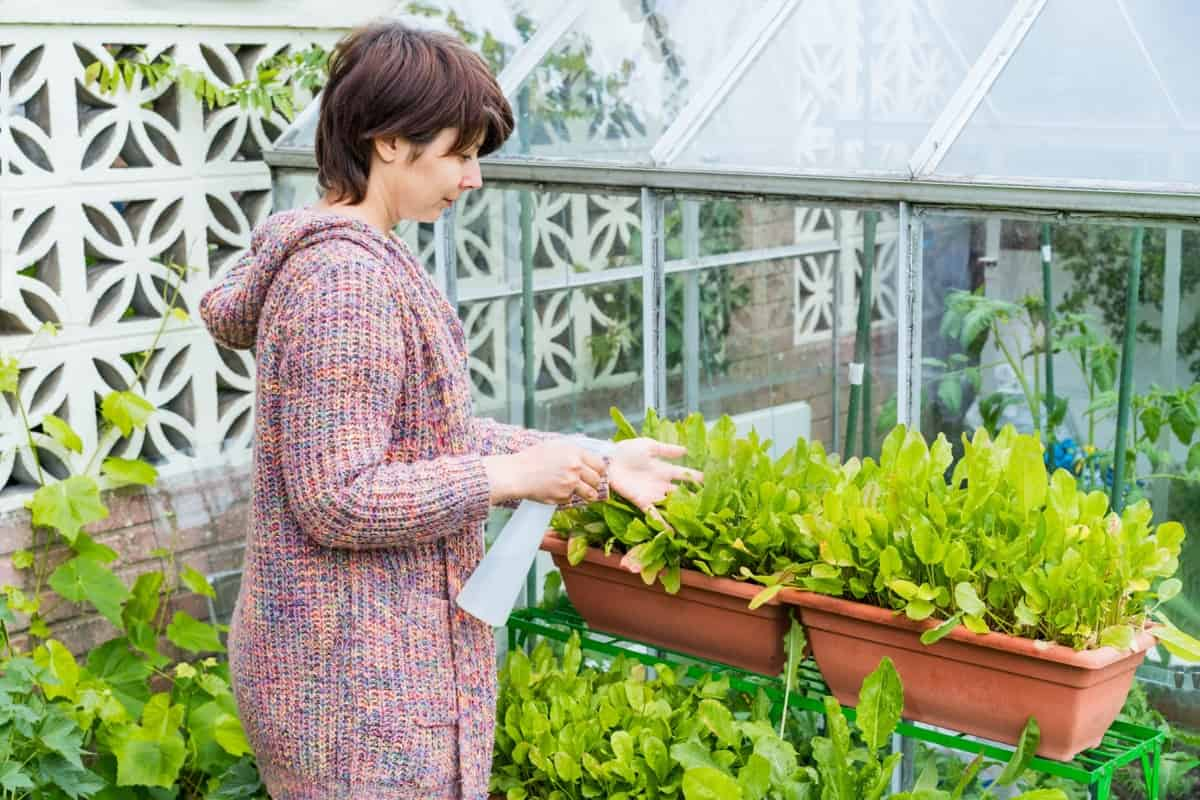A kitchen or potager garden is a small-scale vegetable garden typically located near the house or kitchen for easy access to fresh produce. It is a garden designed and planted to provide fresh, seasonal vegetables, herbs, and fruits for consumption within the household. Kitchen gardens are often designed with both functionality and aesthetics in mind.

They are usually smaller than traditional vegetable gardens and are often arranged in a symmetrical geometric pattern. This type of garden can be grown in containers, raised beds, or in-ground plots. The produce grown in a kitchen garden is typically used for cooking and eating at home rather than for sale. This means that the focus is on producing high-quality, flavorful, nutrient-dense vegetables and herbs free from harmful chemicals and pesticides.
Management of Diseases In Kitchen Garden
Diseases of Kitchen Garden
- Bacterial Leaf Spot: This disease is caused by bacteria that infiltrate your plant’s foliage, causing spots on the leaves. To prevent this disease, water your plants from beneath to avoid splashing soil on them, water them earlier in the day, and clean out your garden each year. If your plant is infected, treat it with a fungicide.
- Rust: This is a fungal disease that causes discoloration on the foliage of your plants. To prevent rust, practice proper thinning techniques, water plants from beneath or earlier in the day, and clean up your garden at the end of each growing season. If your plant is infected, treat it with a fungicide that states it’s meant to treat rust.
- Downy Mildew: This fungal disease that likes damp and cold conditions. To prevent this disease, water your plants from beneath, wash your hands and gardening tools regularly, and pull up and destroy any diseased plants.
- Early or Late Blight: Blight impacts a variety of vegetables but is most commonly seen in tomatoes, eggplant, and potatoes. To deter blight, clean up your garden at the end of each season, water your plants at soil level via soaker hoses, and treat immediately with a fungicide if your plant is infected.
- Corn Smut: This disease can ravage your corn harvest but is considered a delicacy in some cultures.
- Powdery mildew – A white or gray powdery substance on the leaves and stems of plants characterizes this fungal disease. It’s often caused by poor air circulation, high humidity, and warm temperatures. Powdery mildew can affect various kitchen garden plants, including cucumbers, squash, tomatoes, and beans.
- Tomato blight – This disease is caused by a fungus and affects tomato plants. It causes dark spots on the leaves and stems, blackening, and rotting fruit. Tomato blight is common in wet conditions and can spread rapidly throughout a garden.
- Clubroot – This disease affects brassica plants such as broccoli, cabbage, and cauliflower. It’s caused by a soil-borne fungus and can result in stunted growth, yellowing leaves, and wilting. Clubroot is most common in soils with a high pH level and can persist in the soil for several years.
- Verticillium wilt – This fungal disease affects various garden plants, including tomatoes, peppers, and eggplants. It causes yellowing of the leaves, wilting, and eventual death of the plant. Verticillium wilt is most common in soils with poor drainage and can persist in the soil for several years.
- Bacterial spot – This disease affects various garden plants, including tomatoes, peppers, and cucumbers. It causes black spots on the leaves and fruit, stunted growth, and wilting. Bacterial spot is more common in wet conditions and can spread rapidly throughout a garden.
In case you missed it: Management of Pests in Kitchen Garden: Cultural, Biological, Organic, and Natural Control Methods

Management of Disease in Kitchen Garden by Cultural method
- Choose disease-resistant varieties of vegetables while purchasing seeds or seedlings. This can help prevent or minimize the risk of a disease outbreak. Disease-resistant varieties are bred to have some immunity or tolerance to certain diseases.
- Sanitation practices are also important in controlling plant diseases. Keep the garden and surrounding areas clean and free from plant debris, which may harbor diseases. Practice good hygiene by cleaning garden tools and equipment, as they can spread diseases from one plant to another.
- Crop rotation means not planting the same type of vegetable or crop in the same area for consecutive years. This helps to prevent the buildup of soil-borne diseases and pests that affect a particular crop.
- Proper nutrition is essential for plant growth and development, which can help prevent certain diseases. Soil testing can provide information about the soil’s nutrient content and pH level. Based on the soil test results, add the necessary nutrients and minerals to the soil. Inadequate levels of calcium and magnesium in the soil can cause tomato blossom-end rot, a common disease affecting tomato plants.
- Disease-free planting materials like seeds and transplants are another important factor in controlling diseases. Purchase disease-free seeds and transplants from a reliable source.
- Solarization is another effective method to control plant diseases. It involves covering the soil with a clear plastic sheet during the hot summer. The high temperature under the plastic sheet can kill many soil-borne pests and pathogens.
Management of Disease in Kitchen Garden by Chemical method
- Choose the right pesticide: Select a pesticide labeled for use on the vegetable or fruit affected by the disease. Malathion and Permethrin are common insecticides vegetable gardeners use, while chlorothalonil is a fungicide. Copper is an excellent bactericide and fungicide that is approved for use by several organic farming organizations.
- Copper: Copper can control bacterial and fungal leaf spots, powdery mildew, scab, and white rust in most vegetables. However, it should not be mixed with liquid fertilizers as it may burn new growth.
- Potassium Bicarbonate: Potassium bicarbonate can control powdery mildew in all vegetables.
- Sulfur: Sulfur can be used to control powdery mildew in all vegetable
Management of Disease in Kitchen Garden by Biological and Organic method
- Bacillus subtilis: Bacillus subtilis is a preventative fungicide that can be applied early to prevent diseases such as anthracnose, bacterial leaf spot, Alternaria, Botrytis, downy mildew, early blight, late blight, leaf spots, rusts, powdery mildew, and scab in all vegetables.
- Jojoba Oil: Jojoba oil can control powdery mildew in all vegetables.
- Neem Oil: Neem oil can control powdery mildew, downy mildew, anthracnose, fungal leaf spots and blights, botrytis, rust, and scab in all vegetables.
In case you missed it: How to Manage Clubroot in Home Garden: Symptoms, Causes, Cultural, Biological, Chemical, Natural, and Organic Control

Conclusion
Managing diseases in a kitchen garden is crucial to ensure healthy and productive plant growth. Various methods can be utilized, including cultural, biological, chemical, and organic/natural. Each approach has advantages and limitations, and the choice of method depends on the severity of the disease, the type of pathogen, and the gardener’s preferences.
However, it is important to prioritize preventive measures, such as crop rotation, using disease-resistant varieties, and maintaining soil health, to minimize the incidence and severity of plant diseases. By implementing a comprehensive disease management strategy, kitchen gardeners can enjoy the benefits of homegrown fresh produce while contributing to a sustainable and healthy environment.
- Beneficial Insects in Pest Management
- Natural Solutions for Pest Control in Flower Gardens
- Types of Fungicides Used in Agriculture
- Common Issues in the Fruit Development Stage of Pomegranate Farming
- Fruit Development Issues in Papaya: Easy Solutions and Treatment
- Soil-Borne Diseases and How to Protect Your Plants
- Practices to Prevent Disease Spread in the Garden
- From Wilted to Thriving: How to Treat Root Rot Naturally in Houseplants
- Natural Remedies to Cure Brown Spots on Fig Tree Leaves
thanks for info